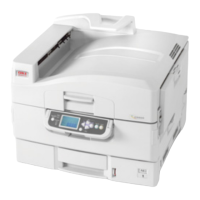A
8-93 Desktop Color Primer
Color Reference Guide for C9800 - 93
When using color text, keep in mind that small font sizes typically do not print in
color with the same sharpness as in black. In most applications, black text prints
exclusively in black toner, while color text usually prints with two or more toners.
Any misregistration between the different toners on paper causes color text to lose
definition. You can make test prints to find the smallest point size at which color text
prints clearly. When using high-end graphics applications that allow you to specify
color as percentages of cyan, magenta, yellow, black, you can create pure cyan or pure
magenta text that prints with the same sharpness as black text. (Pure yellow text is
extremely hard to read on anything but a dark or complementary background.)
Raster images and vector graphics
Two broad categories of artwork can be printed from a personal computer to a color
printer: raster images and vector graphics.
A raster image, also referred to as a bitmap, is composed of a grid of pixels, each
assigned a particular color value (as shown in example a in the following figure).
The grid, when sufficiently enlarged, resembles a mosaic made from square tiles.
Examples of raster images include scans and images created in painting or pixel-editing
applications, such as Photoshop and Corel Painter.
The amount of data found in a raster image depends on its resolution and bit depth.
The resolution of a raster describes the compactness of the pixels and is specified in
pixels per inch (ppi). The bit depth is the number of bits of information assigned to
each pixel. Black and white raster images require only one bit of information per pixel.
Grayscale images require 8 bits per pixel. For photographic quality color, 24 bits of
RGB color information are required per pixel, yielding 256 levels of red, green, and
blue. For CMYK images, 32 bits per pixel are required.
When printing raster artwork, the quality of the output depends on the resolution of
the source raster. If the raster resolution is too low, individual pixels become visible in
the printed output as small squares. This effect is sometimes called “pixelation.”
In vector graphics, picture objects are defined mathematically as lines or curves
between points—hence the term “vector” (see example b). Picture elements can have
solid, gradient, or patterned color fills. Vector artwork is created in illustration and

